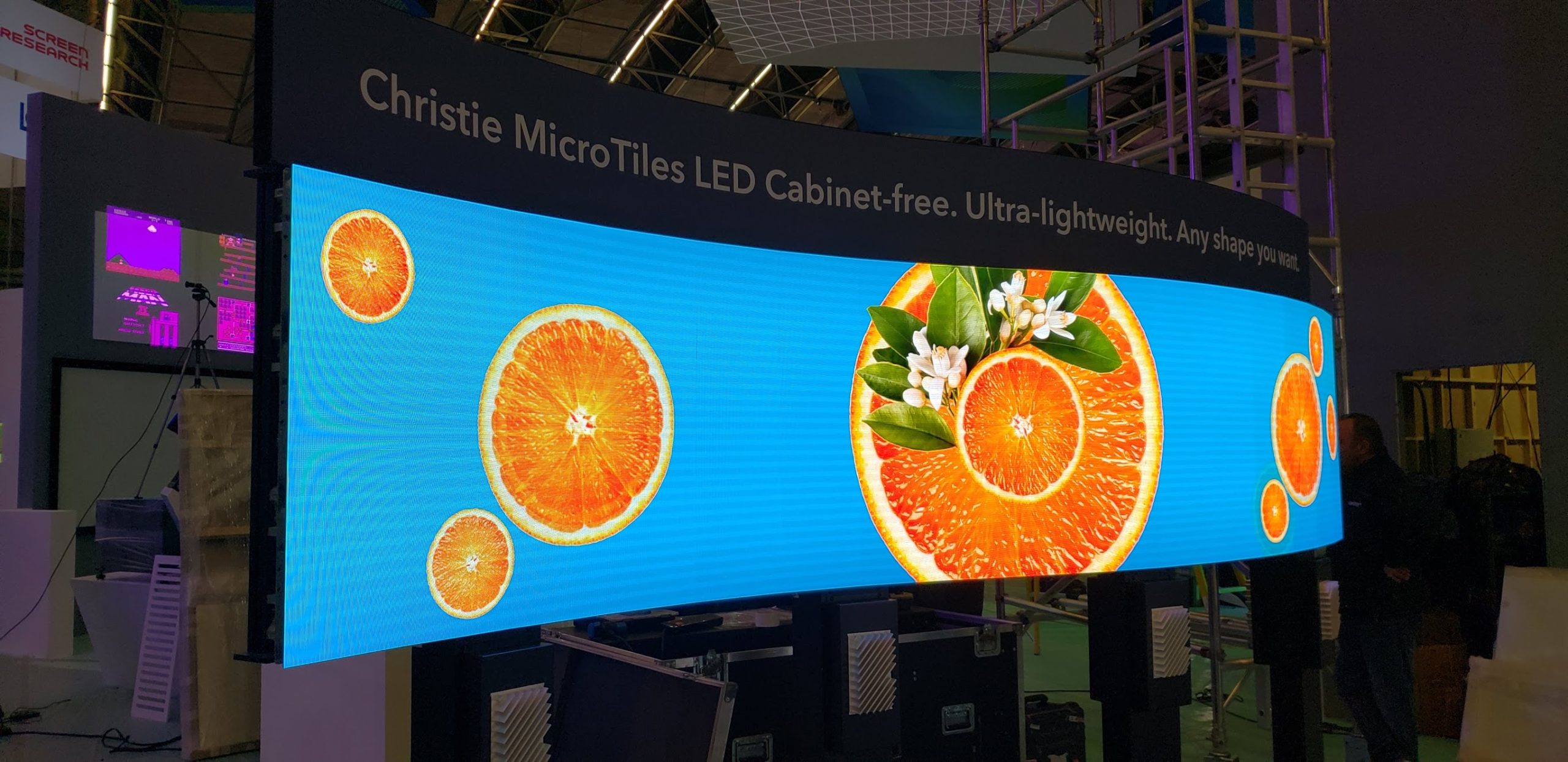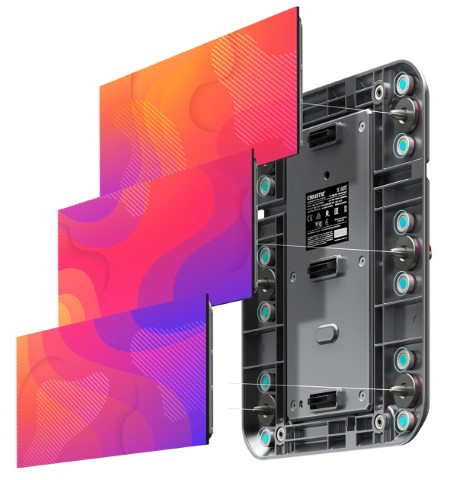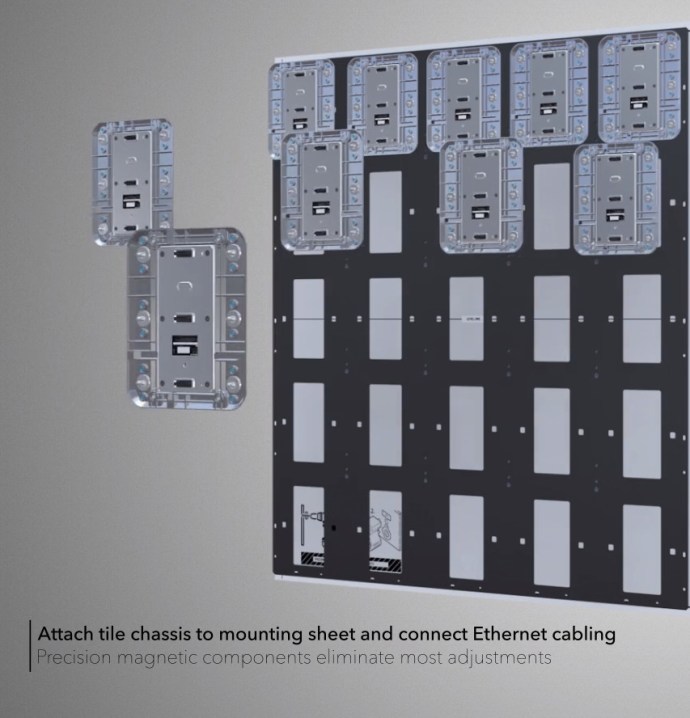
Christie Goes Into The Back-Story Of Its LED MicroTiles
October 1, 2019 by Dave Haynes
When I first saw Christie’s second-generation MicroTiles back this past winter at ISE in Amsterdam, my first reaction was probably like many, as in: “Those are LEDs, not MicroTiles!”
They looked good and had a different structural set-up, but I wasn’t getting it. MicroTiles, as I knew them, were small display cubes unrelated to LED. I even wrote a book about MicroTiles, so I knew them when I saw them.
Many months later, I had a chance to get a lot more detail about what’s different about these displays, and what the thinking was behind them. Last week, Christie brought about a dozen tech journalists to its main R&D and production facility in Kitchener-Waterloo, Ontario, about an hour south of Toronto.
I was the one digital signage guy amidst a bunch of smart people more focused on cinema and commercial AV, and the yappy one asking many of the LED questions.
We got a walk-through of the overall production facility, seeing everything from the production of cinema projectors that are the size of small cars (OK, not quite, but big), very high frame rate video and robotics assembly processes like the precise mirror alignment for laser projectors.
We also saw where the new generation of MicroTiles are being made. I was a bit surprised to see that while some elements are made off-shore, final assembly is in Canada and robotic arms are used to do things like putting the module components together. That saves time and minimizes the pure, hyper-repetitive, soul-robbing grunt work that you see in Chinese assembly facilities.
So … MicroTiles are direct view LED like approximately a bazillion competitive products. But here’s what’s different (I wasn’t allowed to take snapshots, unfortunately):

Shape – With a few exceptions, direct view LED tends to be built and marketed based on what are called cabinets. They’re clusters of LED modules that are married to (usually aluminum or carbon fiber) back-assemblies, with all the electronics and cabling all hived together. To build an LED video wall, you tile and stack cabinets and align them as precisely as you can.
The MicroTiles don’t have cabinets. They have a mounting chassis about the size on an iPad, and the three rectangular modules snap onto the chassis via magnets. The electronics are all on the rear of each module. Two of the chassis side by side create a 16:9 aspect ratio.

Mounting – The system comes with laser-cut mounting sheets and wall anchors, instead of using third-party video wall mount systems. The chassis units just snap in. The only cable/connector is a Cat 6 LAN cable, with the signal and power delivered over Ethernet.
That set-up makes for a super-thin video wall that is ADA-compliant just like contemporary flat panel video walls.
Servicing – Like many LED products these days, it is front serviceable. They pull off with a dry adhesive thingie. They can be popped off and back on while the display is running and there is tech built-in that detects and matches up the unit – existing or replacement – with its neighbors to get color and brightness the same.
The power supplies are external to the displays, with one “octroller” providing the signal and wattage to as many as eight chassis units by Power Over Ethernet.
I won’t into the display quality too much, except to say the 1.25mm I saw looked really good. But many/most fine pitch LED displays look good to my non-technical eyes. The Christie folks have their nerdy arguments about grayscale, flicker, frame rates as to why their version is particularly good.
Marc Lemieux, a Senior Product Developer with Christie, led the effort for these Gen. 2 Tiles, and he walked me through the origins and thinking. Christie started looking at direct view in 2012 and the following year, started marketing a series called Velvet that was hand-selected by the company, but manufactured by a third-party Chinese firm.
Since the, the line has expanded and Christie moved on to a different manufacturing partner. The company continues to market a range of more conventional cabinet-based direct view LEDs for different verticals and at different pitches.
Lemieux says the decision to investigate developing a designed-by-Christie product came out of all the legwork invested into finding a manufacturing partner. There are endless challenges associated with the current way direct view LED cabinets are done, and the tech behind them. All Lemieux saw were compromises associated with competition, cost controls and trying to meet the needs of a broad spectrum of potential buyers.
Christie launched a skunkworks operation about 3.5 years ago. “With the knowledge I gathered from all the OEM products that I had to kind of indirectly support, we figured out maybe there was a better way to do this,” says Lemieux. “And we focused on a totally different mechanical concept, and a very different electronics architecture. “
The first version of the new design, code-named LightBrite, is very similar to the version now being marketed. “There was some internal resistance at first, because it was something different, and some people were wondering why we wouldn’t just buy and resell LED from China, like we are already doing,” says Lemieux. “But once we actually showed it – when we showed our CEO and we showed our parent company – then they were like: ‘Wow! This is really unique.’ It’s a very unique product that has our DNA in it.”
Christie is an interesting company. It went through an odd patch a few years ago, diversifying into some seemingly non-core areas like building experiential media networks in cinemas and selling media space. In a company that was all about engineering, with hallways filled by them, having a media sales unit was undoubtedly weird.
That’s now a separate company that I don’t believe has continued ties with Christie.
Cinema is roughly half of Christies’s business, the rest coming from visual displays for everything from control rooms to retail. Lemieux says LED is a big part of what the company does and will be doing, and there are R&D teams looking five to 10 years out at emerging tech like mini and microLED.
Again, I don’t have the technical chops to say whether whether Christie’s MicroTiles are better visual performers than the endless options out there. But I do see how the mechanical design would warm the hearts of installers and operators who want to be both precise and quick about installs, and work with equipment that’s dead-simple to manage and service.
The company is aiming at the higher-end use cases that put premiums on visuals and form factor. There are 100s of options for commodity LED cabinets, so gearing to premium uses makes more sense and thins out the real competition.




Leave a comment